Images And Reviews : inSalt From The SEEyD Company
Insalt (SEEyD Prequel) Reviews And Photos
(For a Scoop image report of SEEyD’s first widely acclaimed and signature production, Seeyd, see… Scoop Images: Claw Footed Tomatoes Present Seeyd and Scoop Images: Anna Shows How To Be A Seed)
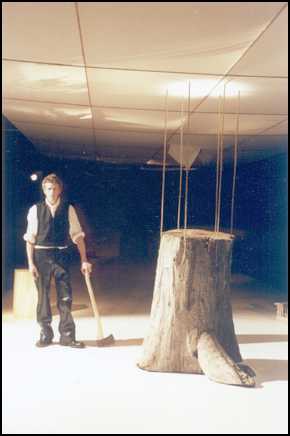

inSalt
The Seeyd Company
Studio 77, Victoria
University
Reviewed by
Lynn Freeman
Capital
Times
inSaft, this intricate, mesmerising and exquisite take on colonial New Zealand, of power, ownership, love and ignorance, of offences unintended and intended, is without question the production of the year. It's a stablemate of the equally extraordinary Seeyd of 2000, in fact it's a prequel.
Months of research and devising have gone into inSalt. It shows in the multi-layered characters and gripping performances, in the set of wrap around white with its shadows and diffused light, in the insights into the meeting of alien cultures on land prized by all who tasted its rich wilderness. This is no dry textbook history of New Zealand, nor does it take sides. Instead it's an intelligently conceived and presented story encapsulating the colonial period of New Zealand history.
You meet Sara and Gabriel Plowright, straight off the boat from England; staggering under the weight of a coffin as they walk onto their isolated patch of land. As Gabriel eulogises over the beauty of the landscape and birdlife, he carries in his hand an axe to clear the land. He and Sara's lives depend on it. At the same time Sara experiences the new land through her relationship with Maka, a young and proud Maori who asks why Pakeha "have these things that we don't". But when he's dressed in Pakeha clothes and posed for photographs alongside Pakeha colonisers, and when his beliefs are threatened, he has to make a choice.
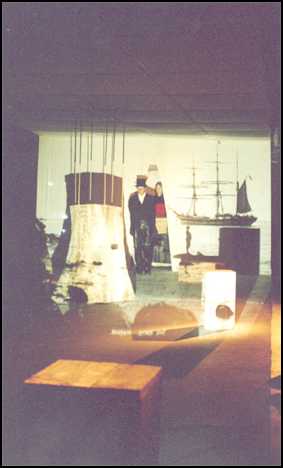
In the midst of this are an Italian Catholic priest who is drawn into the lives of his charges and a young Maori woman given to a rival tribe as a peace offering. It's a tinderbox, this patch of land, and lines of communication are far from open.
While the production is stylised in its form the performances are strikingly 'real' and beautifully nuanced. These five actors move you to your core. As Sara and Gabriel, Heather O'Carroll and Tim Spite are strangers in a strange land whose relationship fractures as they respond differently to what they encounter. Nancy Brunning is incredibly powerful as Marire as she challenges the Rob Mokaraka's powerful Maka over his desire for the colonists' items and what they represent. Richard Edge juggles Maori, Italian and English effortlessly as Roselli the troubled priest and missionary, and captures deftly the many dilemmas which torment him.
The gorgeous lighting by Nyree Andrews and rich soundscape by Peter Edge complete a production that offers everything you could possibly hope for. My expectations of inSalt were impossibly high. They have been met and surpassed.
*****
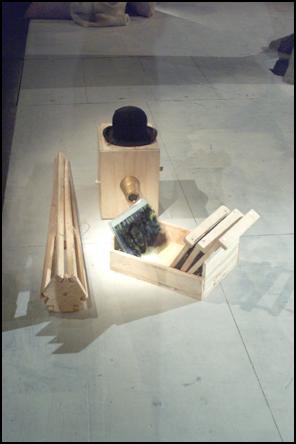
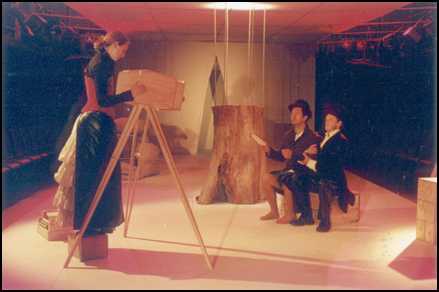
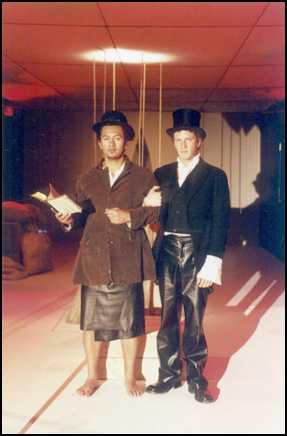
*****
Dominion. Reviewed by Timothy O'Brien. Nov 19th 2001.
"KORERO
Italiano?"
That's the surprising question posed to new
settler Sara Plowright
(Heather O'Carroll) by a Maori
chief, Maka (Robert Mokaraka), when he drops in on her.
It prefigures dialogue in Maori, English and Latin as well as Italian because we are in colonial New Zealand where everything is up for grabs. Sara and her husband Gabriel(Tim Spite) are taking up land that the locals aren't aware they've sold.
Maka and his slave/wife, Marire (Nancy Brunning), speak Italian because their primary contact with the European world comes from Roselli (Richard Edge) an episcopally - clad priest who's living in the bush with them.
Sara is also a photographer who begins by taking landscape views. But as she associates with Maka her interest moves to the close-up view as she photographs plants and records their Maori names.
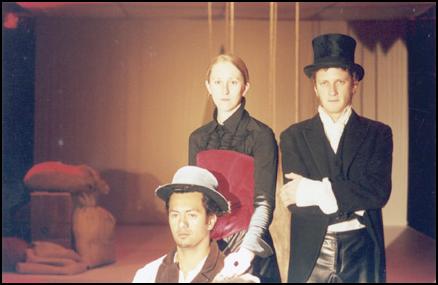
Thus she begins the process of becoming local.Her switch from the would-be landowner's large scale view to an intimate knowledge of what it contains, outlines her psychological shift from settler to resident and also mirrors her increasingly close involvement with Maka.
This new play is the second part of a projected trilogy that began with last year's highly successful Seeyd, a look at genetic engineering counterpointed with an organic farming couple's infertility problems. With inSalt — the title refers to the method of fixing the image in Sara's photographic process — the company tackles a more complex range of ideas.
Among them are stated to be the ideas of control as it relates to land and relationships. Photography is an element of control by recording and showing people things in what they take to be a factual and neutral "fixed" way. Yet even in these days long before the airbrush or Photoshop, the evidentiary role of photography is capable of subjective manipulation, the fix easily becomes a "fix-up".
The production has all the virtues that made Seeyd so notable: a very strong visual style expressed in excellent costumes by Andrea Moore, Nyree Andrews's lighting and Peter Edge's strong score and sound design.
There are some problems. The ideas are more complex than those in Seeyd and aren't as well tied to the personal relationships that again involve a wife opening up to a new world as her husband stubbornly struggles to control its environment.
The long set makes for a lot of striding by the actors and with the dissipation of energy that this creates in the first half hour of the play, it's hard to focus on what it's all about.
However, when Sara and Maka begin to work together the show starts to cook as Mokaraka and O'Carroll (a surprisingly strong match) powerfully display a relationship literally based on chemistry.
Despite some reservations this is a fascinating piece, its 80 minutes rewarding the viewer by sparking thought. Roll on part III.
*****
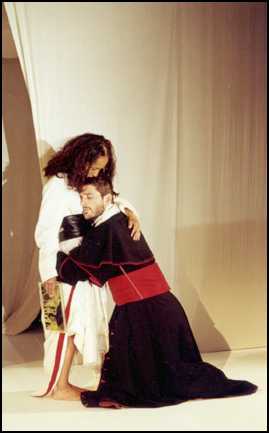
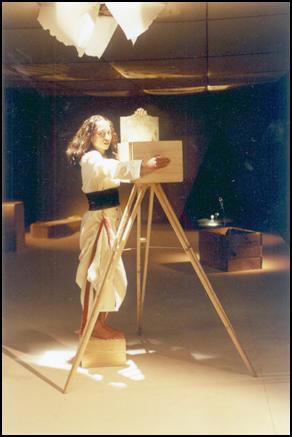
*****
What: inSalt, the
SEEyD Company
Where: Studio 77. 77 Fairlie Tce,
Kelburn.
until December 15. $10/$15/$20
Reviewed by:
Ewen Coleman. Evening Post Nov 19th 2001
A canopy of canvas stretching the theatre's entire length, over a white floor - the Land Of The Long White Cloud - greets the audience as it enters to watch inSalt, a prequel to last year's Fringe Festival hit SEEyD.
Set in colonial New Zealand, the floor is dotted about with unpainted wooden boxes and crates - pristine and untouched - like the landscape at the play's centre. Around these, three cultures vie for control of this landscape and each other - the colonising pakeha, owner of the crates, the Maori landowner and a zealous Catholic priest.
Like SEEyD with its arguments for and against GE and the right to control our destiny through GE, inSalt, with its many connotations on the name, is about the destiny and control of the local people and their land.
And like SEEyD, inSalt doesn't take sides, instead showing how miscommunication, innocence and naivety mixed with misdirected compassion can cause hurt and suffering between couples and communities that may never be healed. Like SEEyD, it is an invigorating and innovative take on a common theme, both in the play's structure and its production.
It is economically written and tightly directed, with good shaping to contrast the more poignant moments of the love story with the tension that develops between Maori, pakeha and priest. It also uses a liberal mixture of English, Maori and Italian, putting the audience squarely in the place of the characters in their predicament of not understanding what is being said.
But such was the passion and commitment of the five actors and the power of their acting that the meaning behind the lines was always plainly evident.
In the central role of the English settlers were Tim Spite as Gabriel, the epitome of the earnest young immigrant determined to make a go of it, and Heather O'Carroll as Sara, the dutiful wife, eagerly following until her gullibility becomes her downfall.
Likewise, Robert Mokaraka's Maka, one moment the warrior, the next an innocent child, follows a similar fate as he becomes fascinated by Sara's camera. His inquisitiveness, however, soon has dire consequences. In contrast to this is Marire, played by Nancy Brunning, who is from another tribe. Always the suspicious one, watching, waiting, a warrior as well, she was also able to show Marire's fragility, like a rabbit caught in a car headlight.
And finally there is Father Roselli, played by Richard Edge, whose ability to slide from English to Italian to Maori all in one speech was awesome to say the least.
Special mention must also be made of Peter Edge's soundscape, beautifully compiled, providing a subtle background of sounds against which this creative group of actors from SEEyD were once again able to show that innovative theatre is alive and well in Wellington.
*****
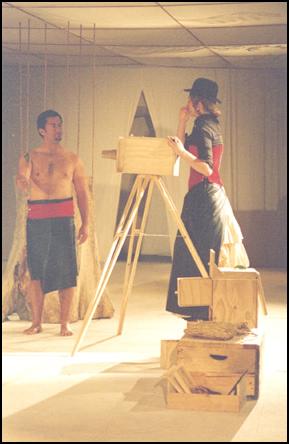
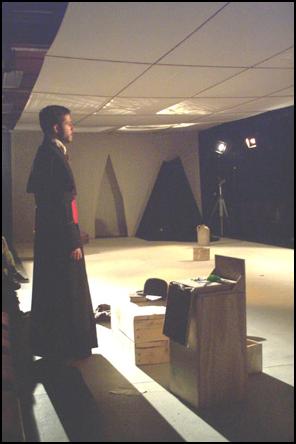


 Martin LeFevre - Meditations: Regarding Popes, Dopes And Hopes
Martin LeFevre - Meditations: Regarding Popes, Dopes And Hopes Binoy Kampmark: Fantasy And Exploitation | The US-Ukraine Minerals Deal
Binoy Kampmark: Fantasy And Exploitation | The US-Ukraine Minerals Deal Gordon Campbell: On The Aussie Election Finale
Gordon Campbell: On The Aussie Election Finale Martin LeFevre - Meditations: The Enlightenment Is Dead; What Is True Enlightenment?
Martin LeFevre - Meditations: The Enlightenment Is Dead; What Is True Enlightenment? Ian Powell: Widening Gap Between Health System Leadership And Health Workforce
Ian Powell: Widening Gap Between Health System Leadership And Health Workforce Keith Rankin: The Great World War 1914-1945 - Germany, Russia, Ukraine
Keith Rankin: The Great World War 1914-1945 - Germany, Russia, Ukraine